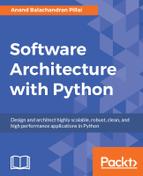We have already seen some aspects of modifiability in the previous chapter. Let's discuss this a bit further and look at some of the related quality attributes that are closely related to modifiability:
- Readability: Readability can be defined as the ease with which a program's logic can be followed and understood. Readable software is code that has been written in a specific style, following guidelines typically adopted for the programming language used, and whose logic uses the features provided by the language in a concise, clear way.
- Modularity: Modularity means that the software system is written in well-encapsulated modules, which do very specific, well-documented functions. In other words, modular code provides programmer friendly APIs to the rest of the system. Modifiability is closely connected to reusability.
- Reusability: This measures the number of parts of a software system, including code, tools, designs, and others, that can be reused in other parts of the system with zero or very little modifications. A good design would emphasize reusability from the beginning. Reusability is embodied in the DRY principle of software development.
- Maintainability: Maintainability of a software is the ease and efficiency with which the system can be updated and kept working in a useful state by its intended stakeholders. Maintainability is a metric, which encompasses the aspects of modifiability, readability, modularity and testability.
In this chapter, we are going to go deep into the readability, reusability, and modularity aspects. We will look at these one by one from the context of the Python programming language. We will start with readability first.
..................Content has been hidden....................
You can't read the all page of ebook, please click here login for view all page.
